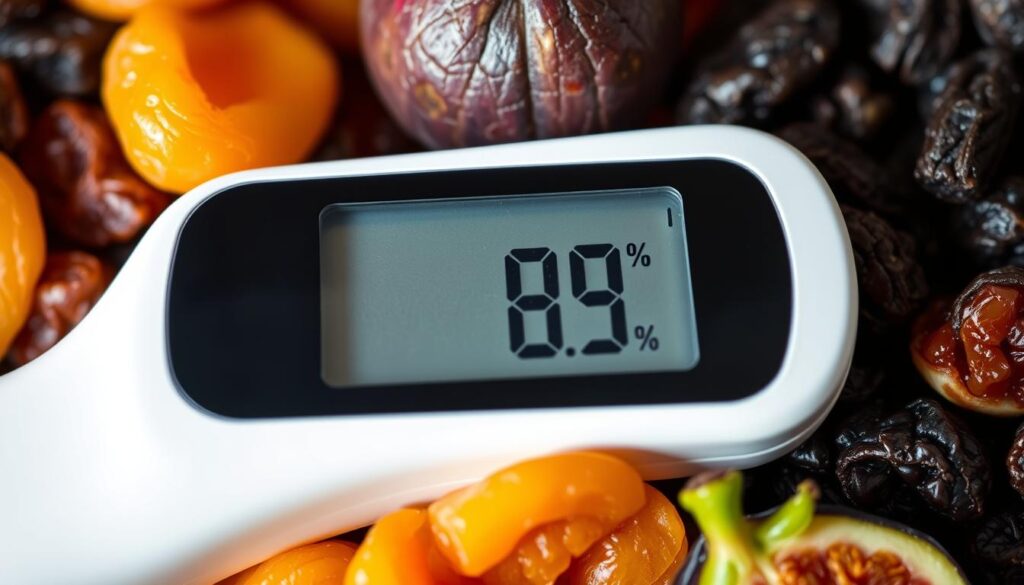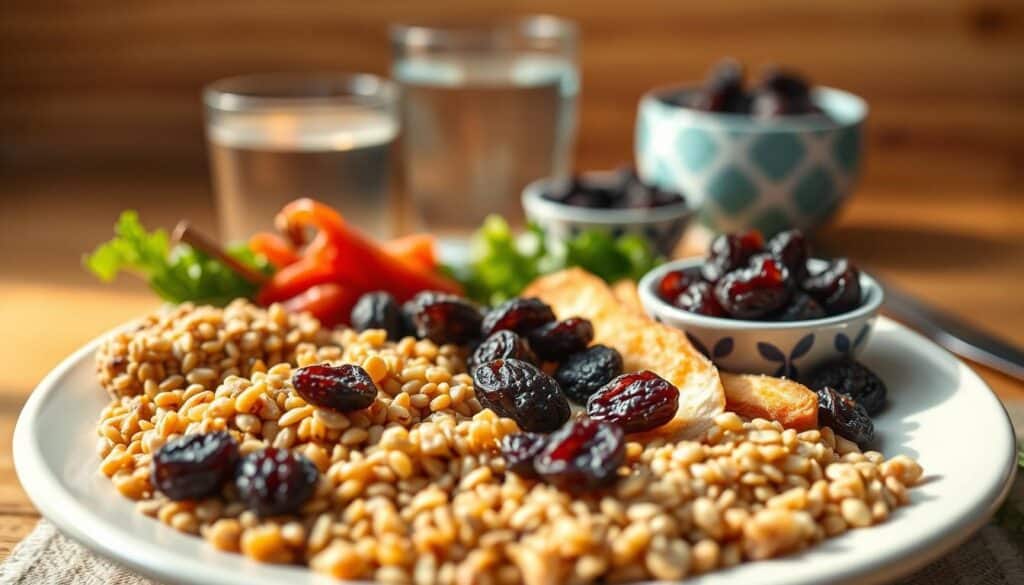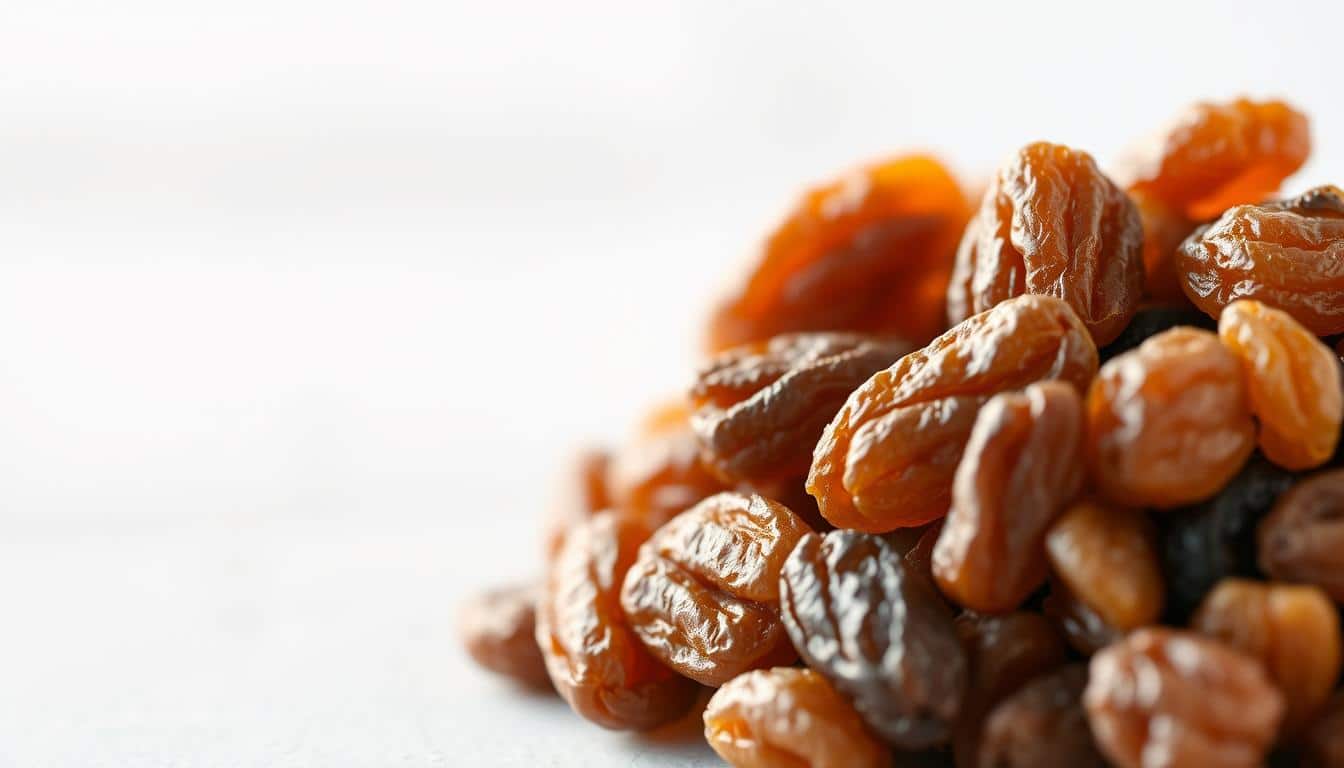Managing blood sugar levels requires careful food choices, especially when considering sweet snacks. This raises questions about dried fruit like raisins and their role in a diabetes-friendly diet. Let’s break down the facts to help you make informed decisions.
Dried grapes pack natural sweetness alongside nutrients like potassium, iron, and fiber. A 2-tablespoon serving contains roughly 15 grams of carbs, making portion control essential. When eaten mindfully, they can add flavor and texture to meals without disrupting your daily carb amount.
Research shows that pairing raisins with protein or healthy fats may slow sugar absorption. This approach helps prevent spikes while letting you enjoy their benefits. We’ll explore practical strategies to incorporate them into snacks, salads, or oatmeal while staying within your targets.
This article examines the latest studies and offers actionable tips for balancing taste and nutrition. You’ll learn how to enjoy this versatile ingredient without compromising your health goals.
Introduction to Raisins and Diabetes
Balancing nutrition and blood sugar control requires informed food selections. Dried fruits like raisins often spark questions due to their concentrated sweetness. Let’s explore their place in a diabetes-conscious lifestyle.
Understanding Raisins as a Dried Fruit
Raisins begin as fresh grapes, losing water content during sun-drying or dehydration. This process intensifies their natural sugars while preserving fiber and nutrients like potassium. A small box (1.5 ounces) contains about 34 grams of carbohydrates, so measuring portions matters.
The Role of Fruit in a Diabetes-Friendly Diet
Whole fruits provide vitamins and antioxidants that support overall health. Unlike processed snacks with added sugars, their natural sweetness comes paired with digestion-slowing fiber. Pairing them with protein sources—like nuts or yogurt—helps stabilize glucose responses.
Research indicates that moderate fruit consumption doesn’t negatively impact blood sugar management when counted toward daily carb goals. The American Diabetes Association recommends focusing on whole options over juices or sweetened varieties for better nutrient density.
The Nutritional Benefits of Raisins
Understanding the nutrient profile of dried fruits helps you make smarter dietary choices. A ¼-cup serving provides 123 calories, 3 grams of fiber, and essential minerals like calcium and potassium. This balance makes them a nutrient-dense option compared to many processed snacks.
Key Vitamins and Minerals
Calcium in these dried fruits supports bone health, while potassium aids muscle function and blood pressure regulation. They also contain iron, which helps transport oxygen through your bloodstream. These nutrients work together to promote overall wellness, especially when managing blood sugar levels.
Fiber and Its Health Advantages
The fiber content slows digestion, helping you feel full longer and stabilizing glucose absorption. This reduces sudden spikes, making portion-controlled servings a practical addition to meals. Pairing them with protein-rich foods like almonds further enhances this effect.
Though naturally sweet, their low calorie count per serving fits well into balanced eating plans. Including them mindfully allows you to enjoy their benefits without compromising your daily carb goals.
Are Raisins Good for Diabetics? A Detailed Look
Exploring how foods interact with your body’s chemistry is key to maintaining stable glucose levels. Let’s examine scientific insights about this popular dried fruit’s effects on metabolic health.

Impact on Blood Sugar Levels
Research reveals surprising benefits when pairing certain foods. A study showed participants who ate raisins with white bread had 26% lower post-meal glucose spikes compared to bread alone. The fiber and antioxidants in dried grapes slow sugar absorption, preventing sudden surges.
Portion size remains critical. A 1-ounce serving contains 22 grams of carbs—enough to affect your daily totals. Pairing small amounts with proteins like Greek yogurt creates balanced snacks that satisfy cravings without chaos.
Understanding the Glycemic Index
With a medium glycemic index score of 53-64, raisins release energy gradually when eaten in moderation. This ranking means they affect glucose less dramatically than high-GI foods like white rice or candy.
Their natural sugars come bundled with nutrients that offset potential spikes. Potassium supports insulin sensitivity, while iron aids oxygen transport—factors that matter for long-term management. Monitoring your body’s response helps tailor intake to personal needs.
Incorporating Raisins Into Your Diabetes-Friendly Meal Plan
Smart food choices become powerful tools when managing diabetes. Integrating dried fruits like raisins requires strategy, not guesswork. Focus on pairing them with nutrient-rich partners and tracking portions to maintain balance.

Balancing Carbohydrates and Portion Control
Two tablespoons of dried grapes provide 15 grams of carbs—equivalent to one small fruit serving. Measure portions using a kitchen scale or measuring spoons to stay within daily targets. Swap sugary granola bars for this snack to reduce added sugars while satisfying cravings.
Complementary Foods for a Balanced Diet
Pair dried grapes with almonds or cottage cheese to slow sugar absorption. Add a sprinkle to oatmeal or quinoa salads for texture without overwhelming your carb count. Research shows combining them with whole grains improves glucose response by 18% compared to eating alone.
Try mixing ¼ cup into Greek yogurt with cinnamon for a protein-packed breakfast. Use them in homemade trail mix with pumpkin seeds and dark chocolate chips for sustained energy. Always adjust other carb sources in your meal to accommodate this addition.
Tracking intake using apps or journals helps maintain accountability. Small adjustments let you enjoy flavor variety while prioritizing blood sugar stability. Consistency with these practices builds confidence in making empowered dietary choices.
Research and Statistics on Diabetes and Raisin Consumption
Scientific evidence plays a crucial role in shaping dietary strategies for chronic conditions. Recent studies highlight how specific foods interact with metabolic health, offering actionable insights for daily choices.
Insights from Recent Studies
A 12-week randomized trial examined 46 adults with type 2 diabetes. Participants who ate a small daily portion of dried grapes saw 19% lower post-meal glucose levels compared to those consuming processed snacks. Systolic blood pressure also dropped by 6 mmHg on average.
Researchers noted these benefits likely stem from the fruit’s fiber and antioxidant content. This supports their inclusion in balanced eating patterns when portion sizes align with carb goals.
CDC and Diabetes Statistics Overview
Over 38 million Americans live with diabetes, while 98 million have prediabetes, according to CDC data. Managing blood sugar through diet becomes vital to reduce complications like heart disease.
The study’s findings suggest incorporating nutrient-dense snacks could help address these challenges. Pairing dried fruits with proteins aligns with guidelines from the American Diabetes Association, emphasizing whole-food solutions over restrictive diets.
Lowering both glucose and blood pressure through simple dietary swaps offers a practical approach for millions. Small changes, guided by research, can create meaningful health improvements over time.
Healthy Raisin Snack Ideas and Recipes
Crafting satisfying snacks while managing glucose levels doesn’t mean sacrificing flavor. Smart combinations of texture and nutrition can keep meals exciting without compromising your goals. Let’s explore creative ways to enjoy dried grapes responsibly.
Quick Energy-Boosting Bites
Pair a tablespoon of dried grapes with 10 raw almonds for a crunchy, protein-rich snack. This duo slows sugar absorption, helping avoid sudden blood glucose spikes. Try tossing them into plain Greek yogurt with cinnamon for extra flavor.
ADA-Approved Meal Enhancements
The American Diabetes Association recommends recipes like Mediterranean unstuffed peppers with quinoa and dried grapes. These dishes balance carbs with fiber-rich veggies and lean proteins. Another option: brown rice salad with edamame, chopped apples, and a citrus vinaigrette.
Roasted chicken over arugula with a sprinkle of dried grapes offers a savory-sweet lunch option. Portion control remains key—stick to 2 tablespoons per serving. Track your intake to maintain weight management goals while enjoying diverse flavors.
Experiment with these ideas to discover new favorites. Small adjustments help reduce health risks while keeping meals enjoyable and nutrient-dense.
Conclusion
Navigating dietary choices with diabetes demands both knowledge and strategy. Research confirms that dried fruits like raisins, when portion-controlled, provide essential nutrients without drastically raising blood sugar levels. Their natural fiber content supports gradual glucose absorption, especially when paired with proteins or healthy fats.
Studies highlight improved post-meal responses and better weight management in those who incorporate small servings into balanced meal plans. The American Diabetes Association emphasizes pairing carb-conscious portions with whole foods to prevent sudden spikes. Always measure servings and adjust other carb sources accordingly.
Consistency with these strategies helps maintain stable sugar levels while enjoying varied flavors. Consult your healthcare team to tailor intake based on your management goals. Start applying these practical steps today to build a sustainable, enjoyable approach to type 2 diabetes care.
FAQ
Can raisins cause a blood sugar spike?
Raisins have a moderate glycemic index (GI) due to their natural sugars, but their fiber content slows glucose absorption. Pairing them with protein or healthy fats—like nuts or Greek yogurt—helps minimize spikes. Always monitor your levels after eating.
How much fiber do raisins provide for blood sugar management?
A 1.5-ounce serving (about ¼ cup) contains 1–2 grams of fiber. While not as high as fresh fruits like apples, this fiber supports slower digestion and better glucose control compared to sugary snacks.
Are there risks to eating raisins with type 2 diabetes?
Overconsumption can raise blood sugar due to concentrated sugars. Stick to small portions (1–2 tablespoons) and avoid varieties with added sugars. Consult your healthcare provider to personalize your meal plan.
Do raisins offer heart health benefits for people with diabetes?
Yes. They contain potassium and antioxidants, which may help lower blood pressure and reduce inflammation—key factors in managing diabetes-related cardiovascular risks.
What are better snack alternatives if raisins raise my glucose?
Opt for lower-GI options like berries, cottage cheese, or almond butter with celery. The American Diabetes Association also recommends hummus with veggies or hard-boiled eggs for balanced snacks.
How does the glycemic index of raisins compare to other dried fruits?
Raisins have a GI of 64, similar to dates but lower than dried pineapple (85). Choose unsweetened varieties and prioritize fresh fruits like pears or oranges for lower sugar content.
Can raisins fit into a weight management plan for diabetes?
In moderation, they can. Their natural sweetness may curb cravings for sugary treats. Track portions and balance them with lean proteins and non-starchy vegetables to support healthy weight goals.


